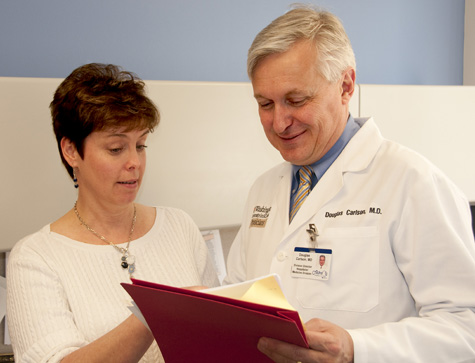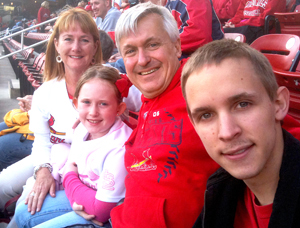
Robert Boston
Douglas Carlson, MD (right), discusses curriculum with Liz Scott, graduate student coordinator in the Department of Pediatrics. “Doug Carlson is one of those rare individuals in clinical medicine who is passionate, energetic, focused and makes things happen,” says Alan L. Schwartz, PhD, MD, the Harriet B. Spoehrer Professor and chair of Pediatrics and pediatrician-in-chief at St. Louis Children’s Hospital.
Douglas Carlson, MD, likes to have a lot to do. His schedule would make almost anyone’s head spin, but Carlson, professor of pediatrics and director of the Division of Hospitalist Medicine in the Department of Pediatrics, handles his busy workload with an ever-present smile.
Carlson arrived at Washington University School of Medicine and St. Louis Children’s Hospital in 1984 for an internship and residency in pediatrics and joined the faculty in 1987. Over the years, he has added more and more responsibilities.
He is the medical director for St. Louis Children’s Hospital CARES (Center for After-Hours Referral Emergency Services) within the emergency room for patients sent by referring physicians. He established the pediatric programs at Missouri Baptist Medical Center and Progress West HealthCare Center, the PAWS (Pediatric Acute Wound Service) sedation program at St. Louis Children’s and Missouri Baptist hospitals, and the St. Louis Children’s Hospital SHARP (Service for Hospital Admissions by Referring Physicians) inpatient referral service and Ambulatory Procedure Center.
And, on top of that, he is co-coursemaster of pediatric medical student education.
Carlson’s colleagues say he is the whole package.
“Doug Carlson is one of those rare individuals in clinical medicine who is passionate, energetic, focused and makes things happen,” says Alan L. Schwartz, PhD, MD, the Harriet B. Spoehrer Professor and chair of pediatrics and pediatrician-in-chief at St. Louis Children’s Hospital. “He has been a terrific champion of our hospitalist program and of medical education.”
“Doug is a team player, an astute clinician, an outstanding teacher and an able administrator,” says F. Sessions Cole, MD, the Park J. White, MD, professor and vice chair of pediatrics and assistant vice chancellor for children’s health. “He is always willing to take on new challenges. He is a great leader in the Department of Pediatrics and the medical school.”
Go with your gut
Growing up in Decatur, Ill., as the oldest of five children, Carlson always was driven. He decided in high school he wanted to become a physician, although no one in his family was a physician. He chose Illinois Wesleyan University because it produced students who were competitive in getting accepted to good medical schools. But that didn’t help Carlson get into Washington University School of Medicine.
“I applied to Washington University School of Medicine, they cashed my check one day and sent a rejection letter the next day,” he says, laughing. “I tell students that my evil plot was to come back here and become a professor.”
It was at Southern Illinois University School of Medicine where Carlson fell in love with pediatrics.
“It gave me a feeling that the other rotations didn’t,” he says. “It would have been fine to be an internist or a surgeon, but it was pediatrics that really stimulated me.”
Carlson firmly believes in following one’s instincts and shares that belief with students.
“I tell students that if your gut is telling you something, go with it,” he says. “You need to get all of the information and all of the data, but in the end, you have to go with the way you feel about something.”
Carlson credits Washington University’s atmosphere of excellence in helping him reach his career goals.
“Working in a place like this, you’re always surrounded by incredibly motivated, intelligent people, and that’s a gift,” he says. “It’s not just that Washington University expects excellence, we also have the infrastructure to help someone achieve it.”
Dedicated to patients
Despite his increased administrative and teaching duties, Carlson still works three clinical shifts a week in busy emergency departments and takes call after hours.

“We’ve gone from 1,000 pediatric patients in the Missouri Baptist emergency room in 1997 to 7,000 last year,” Carlson says. “At Progress West, which opened in 2007, we expect to see 9,000 pediatric patients this year — 8,000 in the emergency room and 1,000 inpatients.”
St. Louis Children’s Hospital’s Emergency Department treats between 55,000 and 60,000 patients a year.
Making the families who bring their children to the emergency rooms feel at ease is one of his top priorities.
“I deal with a lot of families from rural Illinois and Missouri, and I know firsthand what it’s like to come to a big place like this,” he says. “A trip to St. Louis Children’s Hospital can be one of the most stressful moments in a family’s life. We need to make sure we are welcoming, caring and compassionate in addition to providing outstanding medical care.”
Becoming a hospitalist
In 1999, Carlson was looking through a brochure for the American Academy of Pediatrics’ annual meeting when he saw a section on hospital medicine.
“I realized, ‘Hey, that’s what I do,’” he says.
The term “hospitalist” first was used in 1996 to describe physicians who care for hospitalized patients around the clock, stepping in for the patients’ pediatricians or referring physicians when they cannot be there. Since then, the specialty has grown tremendously.
Appointed director of the hospitalist medicine division last fall, Carlson now oversees 38 faculty in the division, which will increase to 42 faculty July 1. The division’s faculty staff the newborn nurseries at Barnes-Jewish Hospital, Missouri Baptist Medical Center and Progress West HealthCare Center as well as the pediatric units at Missouri Baptist and Progress West. Faculty also staff the transport team, which transports children from referring hospitals to St. Louis Children’s Hospital.
“Hospital medicine is increasingly attractive to many of our bright, young pediatric residents, who see a real opportunity within the specialty,” Carlson says. “In hospital medicine, we directly impact the care that kids get in our hospitals. We are able to help with efficiencies and other quality measures.”
Angela M. Sharkey, MD, professor of pediatrics, says Carlson brings genuine enthusiasm and energy to his endeavors.
“His leadership has cultivated faculty who are enthusiastically involved in the missions of the Department of Pediatrics as clinicians, educators and budding researchers,” Sharkey says.
Committed to students
As co-coursemaster of pediatric medical student education with Michele M. Estabrook, MD, professor of pediatrics, Carlson performs one of his favorite jobs: overseeing third-year medical students in their six-week pediatric rotation. Carlson and Estabrook share primary responsibility for about 16 students, who get a broad-based experience in pediatrics.
“The School of Medicine is one of the few schools where third-year medical students can work one-on-one with an attending in a community hospital,” Carlson says. “Using the ambulatory and community hospitals really adds to the students’ experience — they get to see there is another world where patient care is done.”
Carlson relishes his role as a mentor to medical students.
“I enjoy curriculum development, but the part I really enjoy is talking to students about what it means to be a pediatrician,” he says. “Any physician is pleased when a student comes to you and says, ‘Tell me about what you do because I’m thinking about doing the same thing.’”
Carlson says students often remind him why he chose to go into medicine.
“I’ll spend a day at one of our community hospitals with one of our clinical students, who will say, ‘Wow, that was a really cool day because we saw this, this and this.’ And I realize it was a cool day.
“I tell the students often that pediatrics is a gift — not a gift that I give, but a gift that I get every day,” he says.
Fast facts about Douglas Carlson
Birthplace: Elmhurst, Ill.
Family: Wife, Kate, who now stays at home after working for BJC HealthCare for 24 years; son, Erik, 20, a sophomore at the University of Missouri-Columbia; and daughter, Emily, 7. Together, the family likes to take vacations that include hiking, boating and rock climbing. Douglas and Erik take father-son rock-climbing trips together every few years.
Other activities: President of the Southern Illinois University School of Medicine Alumni Board of Governors. Each year, he assists in the White Coat ceremony at the school.
Little-known fact: Carlson was a competitive runner at Illinois Wesleyan University, running track and cross country. While in medical school, Carlson ran the St. Louis Marathon in a blazing 2 hours and 28 minutes.